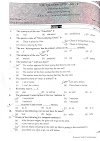Intermolecular Force
The force of attraction or repulsion acting between the molecules are known as intermolecular force.
They are electromagnetic in nature.
They are of two typesThe term "cohesive forces" is a generic term for the collective intermolecular forces (e.g., hydrogen bonding and van der Waals forces) responsible for the bulk property of liquids resisting separation. These attractive forces exist between molecules of the same substance. The term "adhesive forces" refers to the attractive forces between unlike substance such as mechanical forces (sticking together) and electrostatic forces (attraction due to opposing charges). These exist in a fluid and wall of fluid container. Cohesive force and adhesive force are inversely proportional to eighth power of distance between the molecules.
Surface Tension
The property of liquid surface to remain in minimum surface area and behaves like a stretched membrane.
It’s a property unique to fluid.
The surface tension of liquid is defined as the force per unit length in the plane of the liquid surface at right angles to either side of an imaginary line drawn on the surface. i.e. , where = surface tension of liquid
But for soap film as it has two layers.For ring dipped in water as it has inner and outer circumference.
Units: In C.G.S .In S.I. .
Dimension :
It is property of free surface of liquid at rest.
It is a molecular phenomenon and its root cause is the electromagnetic forces.
It depends only upon nature of liquid but not in surface area.
\$
Examples of surface tension:
Lead balls are spherical in shape.
Rain drops and a globule of mercury placed on glass plate are spherical.
Hair of a shaving brush, when dipped in water spread out.
A greased needle placed gently on the free surface of water in a beaker does not sink.
Insects can walk on the free surface of water without drowning.
Dancing of camphor on the water surface.
Soap water cleans cloths well in comparison to impure water.
Effects on surface tension
Highly soluble substance (e.g. NaCl, Sugar) increases surface tension. Sparingly soluble substance (e.g. phenol, soap, camphor, sodium) decrease surface tension.
Increase of temperature increases angle of contact and decreases surface tension.At, critical temperature surface tension becomes zero.
But surface tension of molten cadmium increases with increase in temperature.
Hot soup tastes better than the cold soup.
Machinery parts get jammed in winter.
If there is dust, oil or grease then surface tension of liquid decreases.
Flowing of electricity in the liquid a force acts normally on the free surface of the liquid. Therefore the surface tension on the liquid decreases.
Surface Energy
Surface molecules have more energy than molecules in bulk.
It is also called as surface free energy or interfacial free energy.
It can be defined as the work per unit area done by the force that creates the new surface.i.e. or,
When the liquid drops merge into each other to form bigger drop, energy is released.
Some important formulas
- Work done in forming a liquid drop,
.
Work done in forming a bubble in air, .
Work done in increasing radius of a bubble,.
Work done in splitting a liquid drop into N identical droplets, , where R is radius of drop.
Energy released on coalition of N droplets of radius r into a big drop,
If n small drops of radius r coalesce to form a big drop of radius, R then surface area decreases.Amount of surface energy release, If energy is absorbed by big drop, its temperature rises by = If energy is converted into kinetic energyv=
Angle of contact
It’s is angle drawn tangent to liquid surface and tangent away solid surface at a point of contact.
It lies between O-180.
A.C decreases if sparingly soluble impurity is added.
A.C increases if highly soluble impurity is added to water.
A.C decreases on increasing temperature.
For glass-water A.C is and for glass-mercury pair is nearly (obtuse).
A.C doesn’t depend on inclination of solid.
Cases for angle of contact
When
Liquid which wets solids and rises in capillary tubes. Liquid surface is concave upward.
e.g. water in a glass capillary tube.
When
Liquid which does not wet solids and their level falls in capillary tubes. Liquid surface is convex upward.
e.g. mercury in a glass capillary tube.
When
Liquid which neither rises nor falls in capillary tubes. Liquid surface is plane.
e.g. pure water in silver coated capillary tube.
Capillarity (Capillary Action)
The phenomena of rise or fall of liquid column inside capillary tube. For pure water, =0 ∴h=2Trρg
Height raised or fallen inside capillary tube is= where, T = surface tension of the liquid= angle of contactr= radius of the tubeρ= density of liquidR= radius of the meniscus =r /cosθ
For pure water, =0∴
For a given liquid and solid as a given place. So, i.e. lesser the radius of capillary greater will be the rise and vice-versa.
When the capillary tube is of insufficient length, the liquid will not overflow but adjust radius of curvature.
At , water rises to minimum height inside capillary tube.
The height of the liquid column in a capillary tube on the moon is six times that on the earth.
Some important formulas If the weight of liquid contained in the meniscus is taken into consideration then If the capillary tube is tilted by from vertical, then length of liquid column(l) or
But the vertical height of liquid remains same. i.e. vertical height is independent of same or inclination of capillary tube. When several bubbles of same liquid get coalesced in vacuum isothermally then When several droplets coalesce to form big drop





![[UPDATED] New Syllabus of IOE Entrance Examination |](https://blogger.googleusercontent.com/img/b/R29vZ2xl/AVvXsEj5C60n4l8guBTBqS4sBFaD1z9AoLPnKFQB_f1-F731bzrW_xcCsoewcBcUtqnpJhlf7lL5sOklAtsxRKdgZ-dCQiAgQb1T2X9ck-D_FYoU01fPdPA0mbsulZgmnkS-6-3Hg_CbxBExwn3z5c3-8srStMoZwr6SrmsgF5fPGjnD29T_lg1XsX3aZoIQm9k/w680/pic.png)


![[UPDATED] New Syllabus of IOE Entrance Examination |](https://blogger.googleusercontent.com/img/b/R29vZ2xl/AVvXsEj5C60n4l8guBTBqS4sBFaD1z9AoLPnKFQB_f1-F731bzrW_xcCsoewcBcUtqnpJhlf7lL5sOklAtsxRKdgZ-dCQiAgQb1T2X9ck-D_FYoU01fPdPA0mbsulZgmnkS-6-3Hg_CbxBExwn3z5c3-8srStMoZwr6SrmsgF5fPGjnD29T_lg1XsX3aZoIQm9k/w100/pic.png)
0 Comments